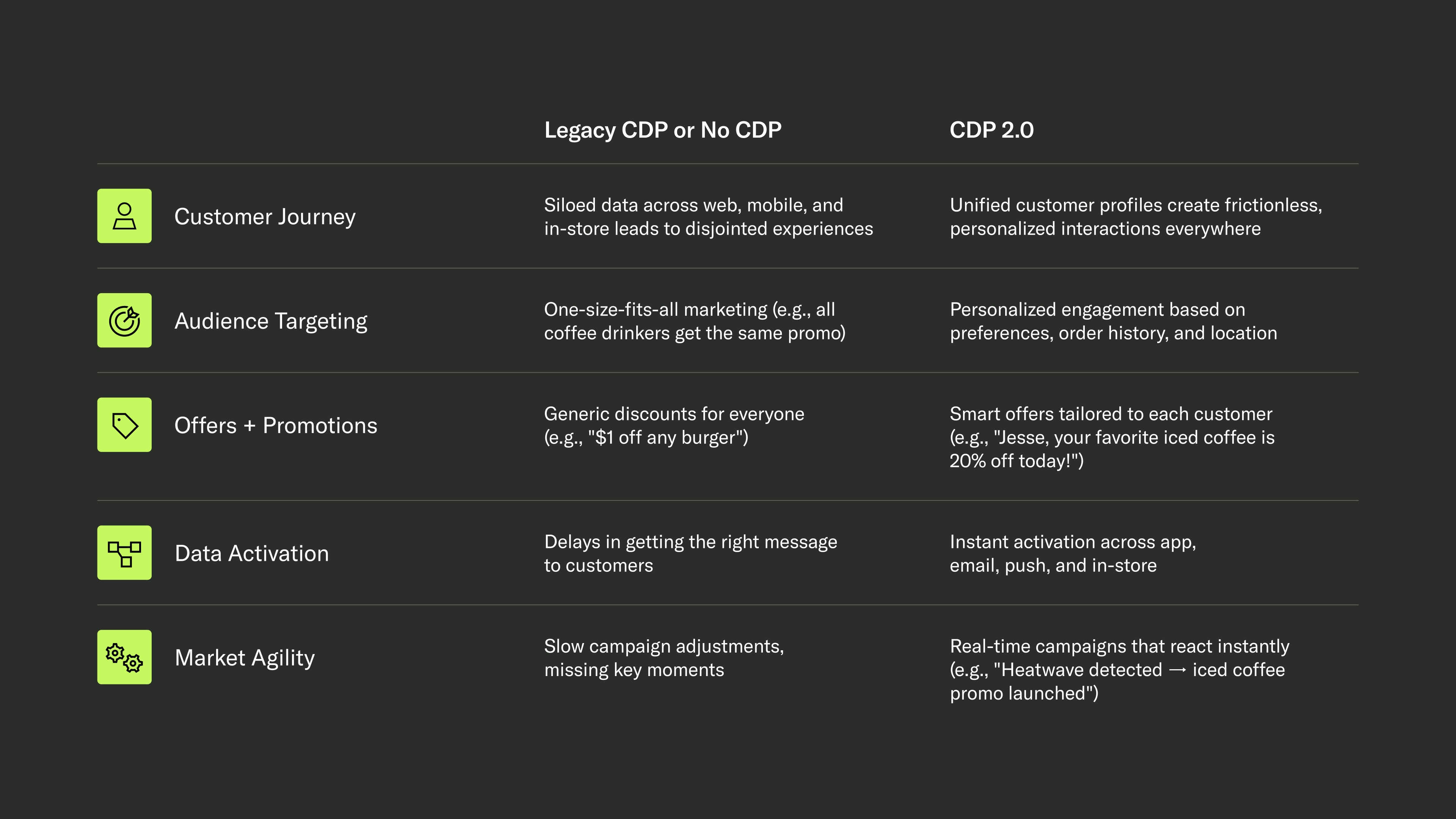Introduction
QSR marketers can no longer settle for a customer data platform (CDP) only capable of ingesting and standardizing data. To execute on the full potential of personalization, marketers need a next-generation approach that enables a strategic shift from data collection to intelligent action. In the race to keep pace with customer expectations, the longer they wait, the further they risk falling behind.
The agility imperative in QSR
As QSR brands pursue the next generation of customer data and personalization, they face an inherent challenge: speed vs. scale.
Corporate marketing teams plan campaigns six months to a year in advance and have to nurture long-term investments in AI and ML to achieve digital transformation goals like hyper-personalization. Global brands also move slowly when it comes to adopting and implementing new technologies. Multiple teams need to weigh in, internal dependencies inevitably arise, and corporate approval cycles crawl along.
These approaches to customer data cause a bottleneck in campaign execution. Individual markets need to execute quickly—promoting iced coffees during an unexpected heatwave or leveraging a partnership with a local sports team during a surprise playoff run. Without access to real-time customer data and campaign execution, opportunities to drive incremental revenue go untapped.
This disconnect between global planning and market needs causes many QSRs to fall behind. Local markets can’t capitalize on timely campaign triggers. Generic menu experiences lead to abandoned app orders. Customer retention declines as personalization efforts miss the mark.
QSR brands can’t afford to wait months to implement new customer engagement strategies. The market demands both standardization for efficiency and agility for local relevance. That kind of balance is difficult to achieve, but rethinking how CDPs support marketing operations make it possible.
The core benefits CDP 2.0 brings to QSR
The next generation of CDP layers new capabilities like AI-powered insights and workflows, optimized performance, and data portfolio management on top of traditional functions like data collection and standardization. This CDP 2.0 helps QSR marketers meet scalability challenges—and ever-increasing consumer expectations—by integrating intelligence to accelerate time-to-value, personalize experiences at scale, and power a continuous loop of improvement.

Accelerated time-to-sustained-value vs. lengthy implementation
The value of customer data isn’t just about collection—it’s about how quickly that data can drive meaningful business outcomes.
Traditionally, CDP vendors have defined time-to-value as “time-to-first-query” or “time-to-first-pipeline-created.” But QSR teams implementing a modern CDP with integrated intelligence should expect actual, immediate business value.
Automated workflows for audience discovery, experiment design, and optimization make it possible for marketers to count time-to-value in days or weeks rather than months. Once implemented, the new CDP should enable teams to capitalize on opportunities to deliver quick, meaningful wins for the business, like instantly activating approved campaigns across locations or rapidly testing new personalization strategies.
As mentioned above, global QSRs will inevitably encounter internal delays when it comes to adopting and implementing a new approach to customer data. But once those hurdles are cleared, CDP 2.0 enables teams to immediately unlock customer data and execute global and local campaigns—greatly accelerating the time-to-sustained-value.
Intelligent personalization vs. simple segmentation
Integrated AI in a CDP enables real-time, intelligent personalization that transforms how QSR brands engage customers across channels and touchpoints—going beyond segmentation to create truly personalized experiences that adapt instantly. For example, when a customer opens a mobile app, their preferences, order history, current location, and other context determine which offers and menu items they see.
Modern CDPs achieve this kind of intelligent personalization by deeply integrating with and complementing the QSR’s internal data assets and resources. Rather than competing with or duplicating the work of internal data science teams, these CDPs should provide transparency into their models and allow organizations to influence how data is processed to improve overall AI capabilities.
Cross-channel consistency is also paramount—as customers move between mobile apps, in-store experiences, and delivery services, their data can be unified, enriched, and activated in real time to personalize experiences across touchpoints.
Especially in a saturated industry like QSR, a brand’s ability to cut through the noise with relevant, personalized experiences can be the difference between becoming a consumer’s go-to choice or blending into the background of endless options.
The continuous improvement loop of CDP 2.0
As QSR brands activate personalization strategies and execute campaigns, CDPs enable a continuous cycle of improvement that adds value over time. This virtuous loop allows global organizations to learn from and respond to customer behavior across all locations.
The cycle begins with comprehensive data collection that captures not just what customers order but also how they interact across channels. These interactions generate insights that trigger automated actions, from personalized offers to menu optimization. Each action is measured in real time, with results automatically feeding back into the system to optimize future engagement. AI and ML personalization models continuously learn and refine without manual intervention.
For instance, when one market discovers a successful tactic—like a high-performing sequence or promotional structure—that learning automatically enriches the entire organization’s playbook. With CDP 2.0, this builds a self-reinforcing system of institutional knowledge where regional innovations compound into global strategic advantages, eliminating the traditional barriers to cross-market learning.

How QSR brands implement CDP 2.0
Here are a few ways QSR brands are harnessing the benefits of CDP 2.0 to improve personalization and campaign performance—driving key outcomes like app downloads, take rate, order values, and customer lifetime value.
Burger King’s intelligent activation
When Burger King set out to drive mobile app adoption, they didn't just launch another free burger campaign. Instead, they created an experiential marketing campaign called the Whopper Detour, playing off a friendly rivalry: Whenever a customer was inside or near a McDonald’s, the Burger King app would use real-time location data to send a push notification offering a 1¢ Whopper within the next hour. Customers would promptly detour to the nearest Burger King to claim their burger.
The 9-day campaign drove a 37.5% increase in app downloads, a 300% increase in mobile order value, and a 40x better coupon redemption rate compared to past campaigns.
To execute the Whopper Detour, Burger King built a tech stack on mParticle’s CDP as the data foundation to collect and harness engagement data—and the connective tissue between partners like Radar for geo-fencing and Braze for email, push notifications, and in-app messaging. The campaign also improved ongoing customer engagement by enriching persistent customer profiles, informing future engagements, and leading to higher spending levels far beyond the initial promotion.
“Despite the fact that the promo lasted for just nine days, the long-term impact of the project is truly significant,” says Fernando Machado, Burger King’s Global Chief Marketing Officer.
Joe & The Juice’s loyalty offers and in-market tests
Global juice and coffee QSR brand Joe & The Juice wanted to improve personalized loyalty offers. By leveraging mParticle as their CDP, they were able to trigger offers based on recent engagements and historical order patterns. The result was a 75.5% increase in loyalty program revenue year-over-year.
The brand also wanted to hone their ability to test new coffee beans or products in controlled environments. Through their CDP, they were able to deliver highly targeted messages to select customers based on store visits. This allowed them to collect valuable insights from customers before launching globally, improving product development and launch success.
Ultimately, democratizing data through their CDP helps Joe & The Juice’s marketers access and activate customer data more easily and build intricate campaigns without requiring specialized data scientists. As Miguel Martin, Joe & The Juice’s Global Head of Digital Marketing, puts it, “Any digital marketer with a little bit of knowledge or training can create really advanced funnels and campaigns using mParticle.”
A global restaurant chain’s rapid market testing
A multi-region chain uses CDP 2.0 to rapidly test, analyze, and iterate on new promotions and menu items in specific locations. This allows them to optimize offerings market by market while maintaining consistent brand standards, leading to significant improvements in customer engagement and operational efficiency.
Multi-brand restaurant group’s unified learning
A restaurant group managing multiple QSR brands leverages CDP 2.0 to share learnings across brands. By implementing intelligent data activation across their portfolio, they could, for example, learn which menu items drive repeat visits across different concepts, identify opportunities for cross-brand loyalty programs, and understand how different customer segments respond to similar offers across brands. This approach allows them to maintain distinct brand experiences while optimizing engagement and marketing efficiency across their portfolio.
CDP implementation considerations for QSR brands
To achieve these kinds of results when implementing CDP 2.0, QSR brands should focus on four key areas:
- Quick-start implementation: Gain a clear understanding of how time-to-value will be defined and achieved, including identifying the high-impact, achievable use cases that can both deliver quick wins and sustained impact.
- Integration best practices: Work closely with internal data science and AI teams to complement existing capabilities rather than replace them. Ensure they have transparent access to model results and decision-making processes to build confidence in the system and improve collaboration.
- Change management strategies: Build support by demonstrating value across multiple stakeholder groups. Corporate teams need to see standardization and efficiency gains, along with improved AI capabilities, while local markets prioritize execution speed and flexibility.
- Success metrics and measurement: Consider global metrics for overall performance as well as market-specific KPIs that reflect local conditions. These can include customer lifetime value (CLV), average order value (AOV), and localized campaign engagement and performance.
The future of QSR with CDP 2.0
Customer data is ready and waiting for QSR brands to improve and personalize experiences across global, market, and local levels. With CDP 2.0, QSR marketers can not only collect but also rapidly activate data to execute hyper-personalized campaigns while creating a continuous cycle of improvement that drives better results over time.
For QSR leaders, the cost of waiting will only increase. Brands that move quickly to implement intelligent customer data activation will create sustainable advantages in customer engagement, operational efficiency, and market responsiveness.
Ready to learn how your organization can accelerate the time-to-value from CDP 2.0? By centralizing, standardizing, and activating your customer data, mParticle enables your marketing team to create personalized, scalable campaigns that drive engagement. Contact our team to explore how our platform makes it possible.




.jpg)
.webp)
.png)
.webp)
.webp)
.jpg)